Doug Moench is up there as one of the most prolific writers of Batman comics ever. From an unforgettable 1983 tale about tentacle sex until the 2009 mini-series Unseen – in which the Dark Knight battles the Invisible Man – Moench has churned out hundreds of stories, approaching Batman’s world in various ways over the years. I’ve been promising to discuss his work for quite a while and now it’s finally here: this week I will focus on Moench’s relatively grounded early stuff, from the eighties, and next month I’ll look into his more bonkers phase, from the nineties.
Picking up immediately where Gerry Conway left off, Doug Moench did a lengthy run on Batman and Detective Comics (plus a few issues of World’s Finest Comics) between 1983 and 1986, with storylines flowing back and forth between series and the kind of stress on character development that had been traditionally associated with Marvel. By then, Moench already had an impressive background as the writer of tons of horror comics, not to mention acclaimed runs on the adventure series Master of Kung Fu and the dark superhero series Moon Knight, so he adapted easily to the Caped Crusader’s corner of the DC Universe. The art was suitably gritty and atmospheric, the bulk of it illustrated by the eerie pencils of Don Newton, Gene Colan, and Tom Mandrake, served well by the noirish inks of Alfredo Alcala and Bob Smith, as well as Adrienne Roy’s muted colors. Notably, this run culminated in the epic Batman #400, the grand finale of Batman’s pre-Crisis continuity, right before the Frank Miller-shaped soft reboot.
Moench built on Conway’s efforts to figure out how to make old concepts work in a mature, modern setting by infusing his comics with elements borrowed from more respected forms of literature. This was similar to what Alan Moore was doing in Saga of the Swamp Thing at the time. Although Doug Moench didn’t go nearly as far as Moore (his work essentially remained within the confines of the original genre), Batman comics, like Swamp Thing, became full of visual puns, ornate narration, gothic motifs, and elaborate (if heavy-handed) symbolism…
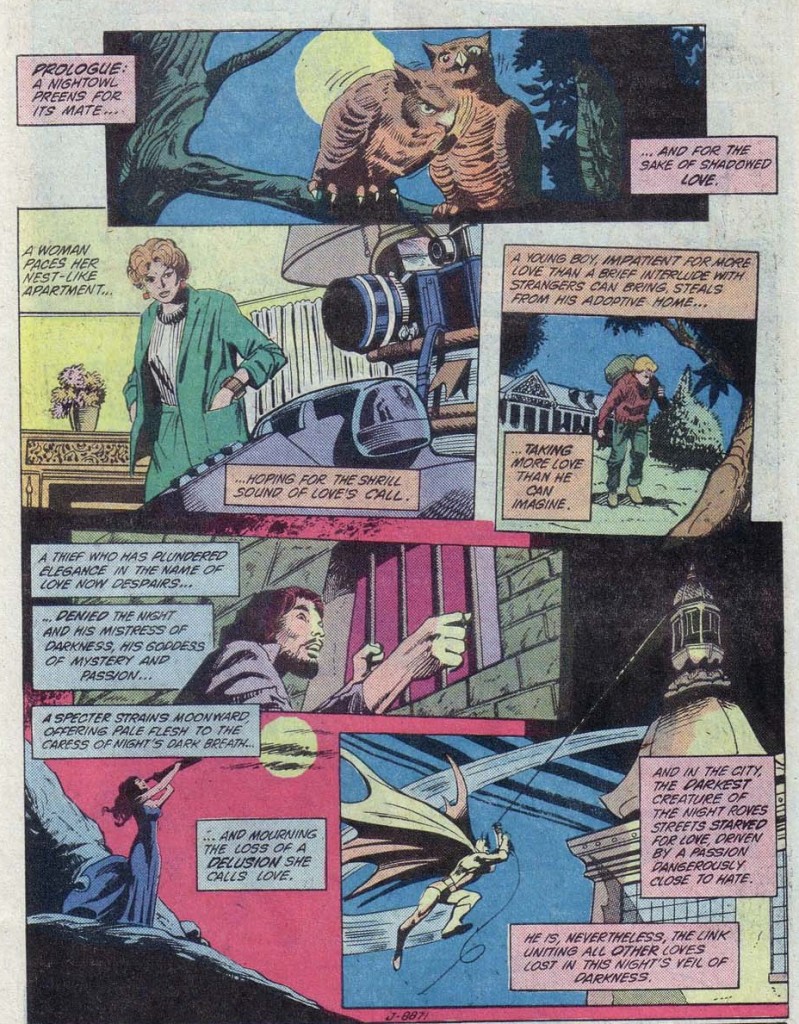 Detective Comics #530
Detective Comics #530
(Yep, you can be sure those owls at the top – representing love and the night – will show up again in the comic, in the most symbolic way possible!)
I can see how some would find Doug Moench’s style cheesy and pretentious, but me, I can’t get enough of this stuff. There are so many layers in these books – this may not necessarily make them deep, yet it sure makes them a stimulating read, providing countless avenues to explore. Sometimes Moench plays with the form – in ‘The Glacier Under Gotham!’ (Batman #375), the framing is all done in rhyme (a cool twist later reveals the narration is actually being done by a character) – and sometimes he has fun with interwoven themes – like in the climax of ‘Facing the dark, blindly’ (Detective Comics #536), where all the characters have to take a chance while blinded, literally or metaphorically.
There is a particularly neat conceptual game in the tandem issues ‘Up above the sin so high’ (Batman #370) and ‘Down below’ (Detective Comics #537). In the former the Caped Crusader tries to bring down a gangster who lives in a skyscraper penthouse, in the latter he tries to convince a homeless man who lives in the sewer to come to the surface. The tales’ thematic connection is further built around both subtle and obvious parallels between the two characters Batman is dealing with (for example, each of them loses a tooth at some point in the story). Even the covers frame the Dark Knight from symmetrical perspectives.
Perhaps the most on-the-nose slice of symbolism shows up in ‘A stump grows in Gotham’ (Detective Comics #552), which draws an obvious parallel between a beloved oak tree getting cut down and Batman seemingly dying at the hands of an outside hitman who promised a bunch of local criminals they could dance on the Dark Knight’s grave. Batman is almost buried in a coffin made from the tree’s wood, but reports of his death turn out to have been greatly exaggerated – just like the tree’s, whose stump is shown to be growing a new plant in the final panel!
The best bit of Moench’s playful use of metaphors and juxtapositions in this issue, though, takes place when Batman, breaking out from his coffin, actually does make criminals dance on his grave:
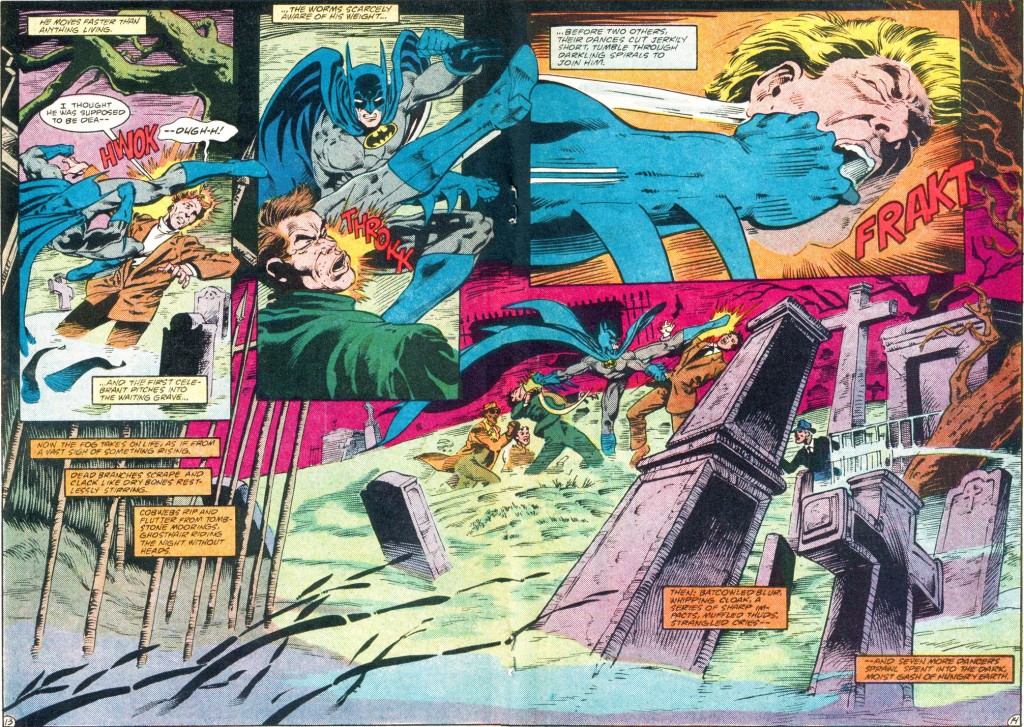 Detective Comics #552
Detective Comics #552
And trust me, you don’t want to get me started on the recurring cat-shaped stalagmite in the Batcave, which represents Batman’s attraction for Catwoman… Doug Moench takes this idea as far as he can and I love every bit of it. In ‘The Batman Nobody Knows’ (Detective Comics #560), Moench goes totally overboard, turning rats, bats, flies, and spiders in the Batcave into an elaborate representation of how the Caped Crusader is trying to manipulate Robin and Catwoman into getting along.
The thing is that these literary devices serve less to distract us from the fact that we are reading a superhero comic than to encourage us to experience the genre with a specific frame of mind, exploiting the allegorical potential of its surreal costumes and tropes. Make no mistake, this is still a lighthearted horror and crime saga (with a few soap opera subplots thrown in for good measure) in which the Dynamic Duo fights bizarre crooks like Calendar Man and Captain Boomerang. For all its flourishes, Moench’s writing doesn’t shy away from delivering the kind of thrills and eccentric criminal schemes one expects from a classic Batman adventure, with a steady balance between solemnity and quirkiness that is not too distant from the BTAS cartoon show of the following decade.
In fact, Moench’s knack for squeezing the most out of each metaphor blatantly informed his most famous villain creation: Black Mask (Roman Sionis) and his mob, the False Face Society of Gotham (introduced in the trilogy Batman #386 – Detective Comics #553 – Batman #387). Absolutely *everything* about Roman Sionis revolves around masks and faces from day one:

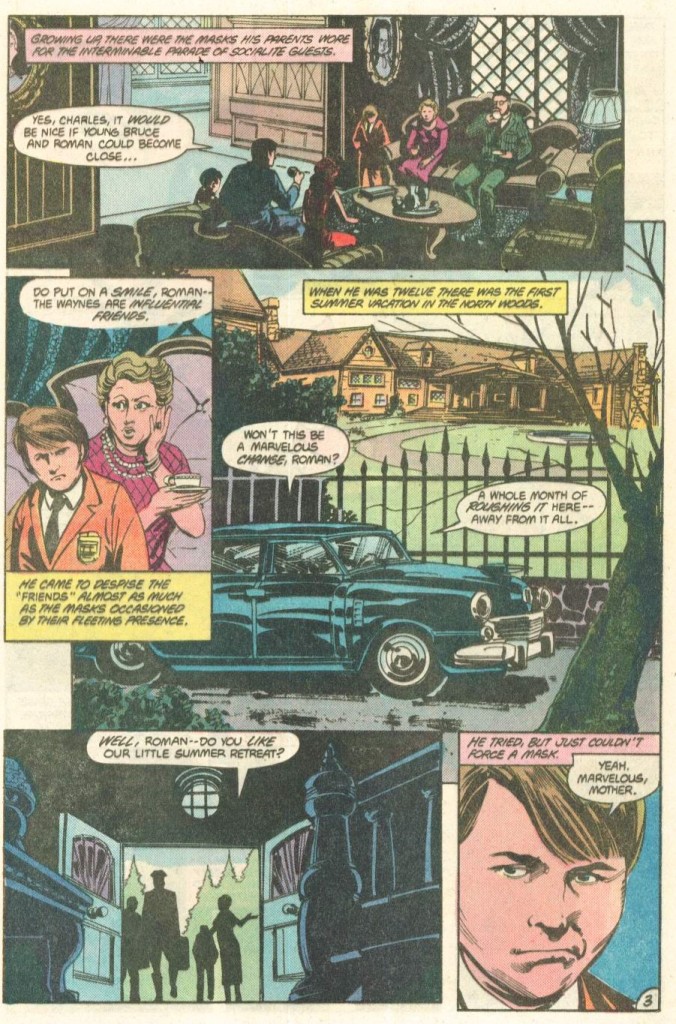 Batman #386
Batman #386
(Masks, of course, are symbolic by definition – and Doug Moench can’t resist reminding readers of this, in quite explicit terms, at every turn.)
Besides Black Mask, Moench has been responsible for many contributions to Batman’s supporting cast. Notably, during this era he also introduces the underrated goth villain/love interest Nocturna and the fan-favorite dirty cop Harvey Bullock, who acts like an old-school hardboiled detective and may or may not be as clumsy as he looks.
Bullock, in particular, had a great entrance into the series, starting out as a stooge appointed by the corrupt Mayor Hamilton Hill in order to screw with Police Commissioner James Gordon…
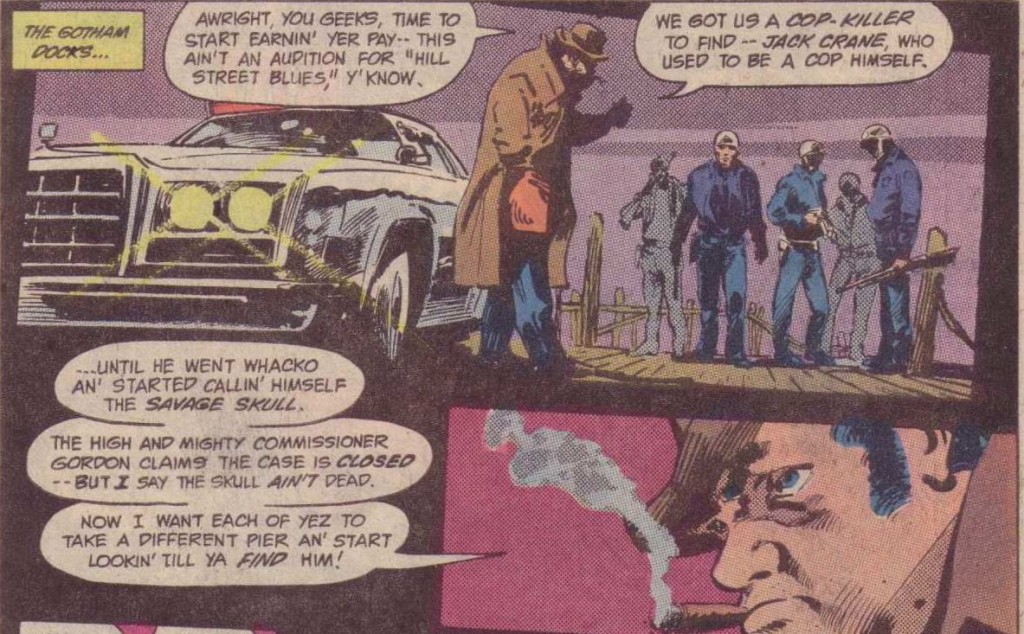 Detective Comics #528
Detective Comics #528
Doug Moench’s run is full of strong characterization all around. For example, Commissioner Gordon feels weighed down by Hill’s and Bullock’s conspiracy to undermine him – in a moment of weakness, he even wishes Bullock gets killed – only to regain his motivation after a pep talk by Batman and later proving himself as a cop. In turn, Jim proves how important he is for the Dark Knight, who gets his own crucial motivational speech from Gordon at the climactic fight scene against the Savage Skull.
Harvey Bullock himself comes across as more than a one-note character. Sure, he looks crooked and buffoonish, but he also has enough of a detective instinct to track down the Savage Skull. Plus, Bullock seems to have a change of heart after being saved by Batman and Gordon… yet he then claims sole credit for the arrest in the end!
There are several other fine character moments. ‘Just as night follows day’ (Batman #383) humanizes the Caped Crusader by showing us a day and night in the life of an exhausted Bruce Wayne, who keeps trying to sleep but is always interrupted. Jason Todd’s insecurities get plenty of attention as well, like in this insightful scene right after Dick Grayson officially passes the title of Robin to Jason (who in the pre-Crisis version used to be a circus acrobat):
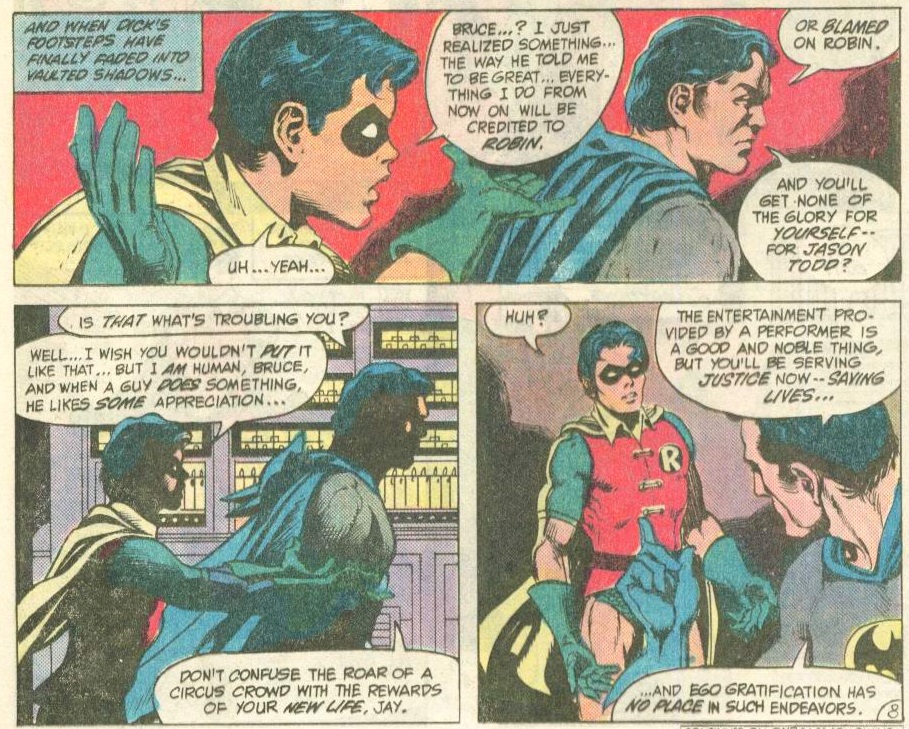 Batman #368
Batman #368
Doug Moench’s thoughtful exploration of the cast benefited from the fact he was the main writer shaping these characters at the time (Joey Cavalieri’s World’s Finest Comics and Mike W. Barr’s Batman and the Outsiders didn’t have nearly as much to say about daily life in Gotham’s city hall or police department or even in Wayne Manor). For the most part, Moench had the chance to develop strong internal continuity between his series without much interference from the rest of the DC Universe, despite the mandatory tie-in to Crisis on Infinite Earths.
On top of the dark(ish) mood and character work, Moench’s stories were often informed by real world issues, thus anticipating to some degree the impending Frank Miller revolution. Not only did these comics explore the internal politics of Gotham City, they also entangled Batman’s adventures with the troubled politics of Central America and the Middle East. Moreover, at one point the Penguin drugged an investigative reporter into telling him everything about the US ‘Early Bird’ defense system and then tried to sell the info to the Russians!
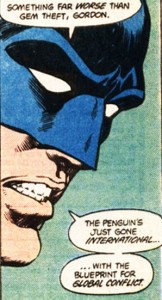 Batman #374
Batman #374
This was only one in a long line of Cold War Batman comics, albeit one with an especially satisfying ending. Doug Moench clearly had quite skeptical views about the need for the Cold War (he also addressed them in his crazy-ass Blackhawk run). The topic came up again in two of my all-time favorite Batman issues (#393-394), in which – three years before Red Heat – the Caped Crusader teamed up with a kick-ass Soviet agent, called Katia:
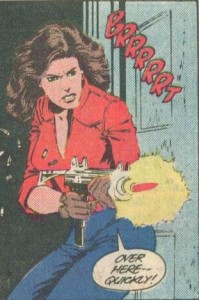 Batman #393
Batman #393
Rather than treating Katia as a proto-Bond girl or as a stereotypical Russian who surrenders to American materialism, Doug Moench established her as a richly nuanced character, who explicitly refused to act like Ninotchka. (Katia showed up again in Vigilante #46-47, having apparently quit the KGB and stuck around Gotham City. Unfortunately, Paul Kupperberg’s script ignored Moench’s interesting characterization and depicted her as just a slimy Russian villainess, manipulating the mob in order to smuggle classified material out of the USA.)
Another fascinating female character who repeatedly confronted Bruce’s politics was Alfred’s French daughter, Julia Pennyworth. She had been created by Gerry Conway (in Detective Comics #501-502), but Doug Moench brought her back into the series as a regular cast member. While turning Julia into a reporter wasn’t very imaginative (it made her look like a Vicky Vale knock-off), Moench cleverly imbued her with a leftist European touch. You can see it in this excerpt from a wonderful sequence that keeps alternating between, on the one level, the juvenile theatrics of masked villains (with simplistic plans and motivations) and, on the other level, an adult world of media negotiation, sexism, class awareness, and international affairs:
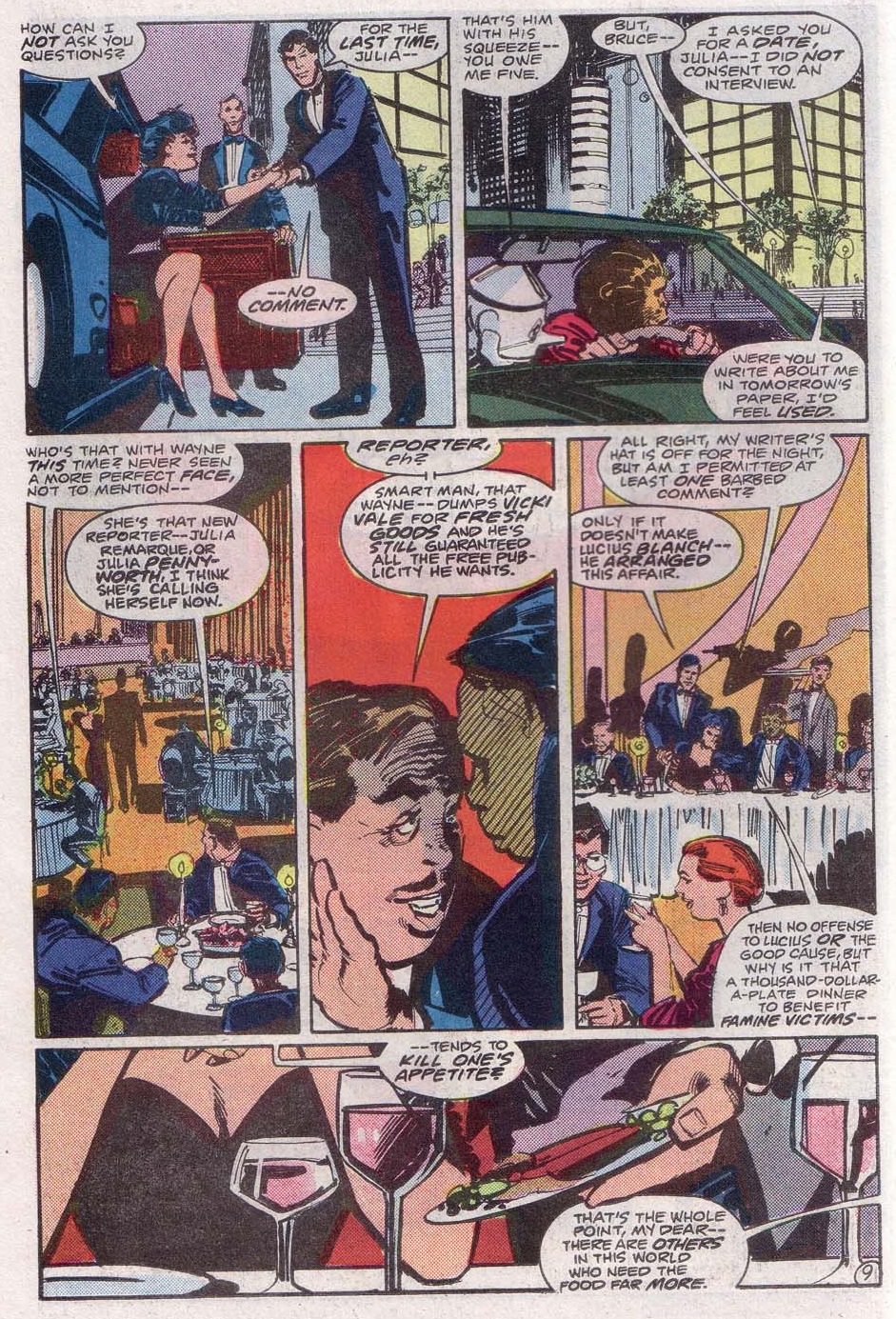 Detective Comics #553
Detective Comics #553
The Caped Crusader’s politics were also addressed in a team-up issue with Green Arrow (Detective Comics #559), in which Batman represented the pro-authority right and Green Arrow the anti-systemic left. That story was called ‘It Takes Two Wings to Fly’ (as in right and left wing, geddit?).
Finally, Doug Moench seemed to really enjoy sneaking pop culture references into his comics. They were crammed with little intertextual gags like this cute wink to Mbube:
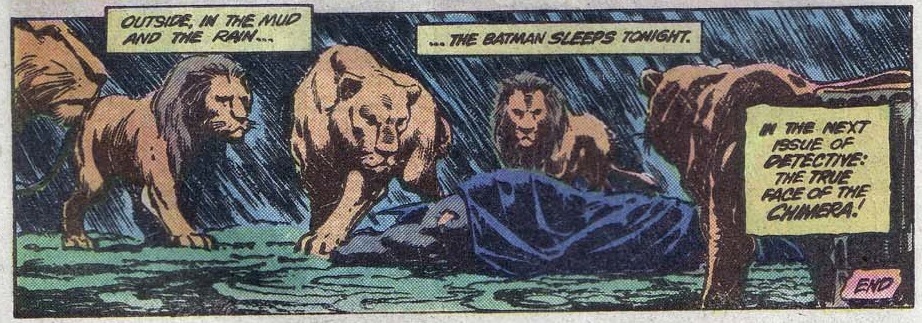 Batman #364
Batman #364
Specifically, Moench channeled his predilection for old Hollywood into the character of Harvey Bullock, whose dialogue consisted mostly of references to classic movie lines. Moench took this to the extreme by introducing a cinephile villain called Film Freak, whose gimmick was precisely that his crimes were reminiscent of movie scenes, including a handful of Alfred Hitchcock ones.
Years later, in 1993, Doug Moench would go back to Hitchcock. When the post-Crisis version of Batman started working together with Catwoman, James Gordon wondered if there could be something to the notion of working with a thief:

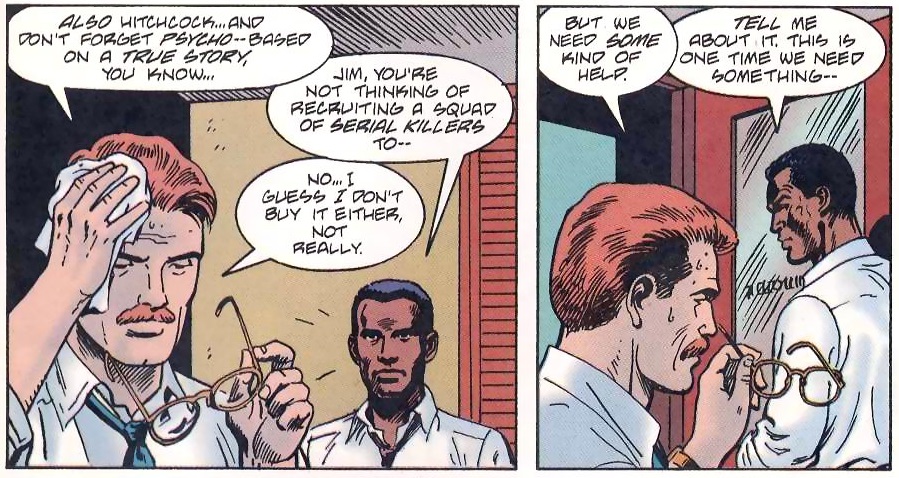 Legends of the Dark Knight #48
Legends of the Dark Knight #48
Indeed, some of Doug Moench’s motifs did carry over into the ‘90s. However, as we’ll see next month, they became much, much more unhinged…

Well, *this* was the retrospective and analytical post I knew you’d do so well. Excellent job. I thought you’d title Moench’s 1983-86 run, “Doug Moench’s Soap Operatic Batman” or “Doug Moench’s Lovesick Batman.” I much prefer and am actually quite pleased by the emphasis on Moench’s literary and symbolic leanings, because many of them, despite being quite obvious, actually eluded me! Good job in providing me with a fresh new perspective on what is a sadly neglected Batman era. I should probably read more literature and fewer comics, though!
Some wag paraphrased Denny O’Neil as saying he “wasn’t interested in Bruce Wayne’s social life”, which I suppose makes Miller’s TDKR look like an even more welcome and wonderful rebirth–sure, I like it and the subsequent eras up to Cataclysm, but I also take exception to those who would dismiss Moench’s first run (and Conway’s stint, as well) because it wasn’t TDKR.
Contentwise, I don’t think Moench was writing anything different than the likes of what Chris Claremont or Roger Stern were also doing so well around that same time. Those who dislike the soap opera elements fail to notice that comic books often *are* soap operatic in nature.
Having said that, I enjoyed the ongoing “soap opera” storylines that Moench has always done so well. As you have pointed out so eloquently before, Moench, (and Conway before him) both brought a Marvelesque continuity that rarely existed in DC books in the 1970s.
Some keyboard warriors refer to Moench’s run as a “low point.” I wish to hell other comics had “low points” as strong as Moench’s Batman/Detective runs with all that “low point” Don Newton, Gene Colan, Tom Mandrake, and Pat Broderick art; not to mention all that pesky supporting character development.
Besides, *someone* must have liked the work Moench was doing as he returned to Batman for another superb– though vastly different run–in 1992-98–which was just as dark and gritty as anything anyone else was doing then. Was Denny O’Neil, the same guy who apparwntly despised Nocturna and the chronicles of Bruce Wayne’s social life, responsible for bringing Moench back?
I’m really glad you like it! I fully agree that these are underrated comics, in part because they were unavoidably overshadowed by TDKR. And yet, as you say, they must have been respected enough for Denny O’Neil to bring Doug Moench back into the bat books for such an extended run in the ‘90s – a run that returned to many of the same characters and situations (including the focus on city politics and Bruce’s love life)
Great blog! Just discovered it.
Pre-Frank Miller 80s bronze age Batman is underrated: consider this – the books did NOT sell well before being given a much-needed shot in the arm by (a) that guy Miller with DKR, Year One, etc; and (b) the Tim Burton 1989 Batman film.
You could argue (I haven’t got a strong ‘dog in this race’, just playing devil’s advocate) that Conway, Moench & co never topped themselves writing Bat-books in the 80s. Bit harsh on Master of Kung Fu, which is an acknowledged classic, but still.
I greatly enjoyed Conway’s stuff for DC, including at the time buying a few late 70s/early 80s JLA as a lad when entering US comix (2000AD was soon to dominate my habits).
Due to 2000AD I skipped a lot of DC & Marvel in the mid-80s so missed Moench’s Bat/’Tec but made up for that for buying tons of it at 90s comic marts.
Loved the moody Newton and Colan art, too.
And CK’s point: “Some keyboard warriors refer to Moench’s run as a “low point.” I wish to hell other comics had “low points” as strong as Moench (…and…) Don Newton, Gene Colan, Tom Mandrake, and Pat Broderick art (..plus..) that pesky supporting character development.” Couldn’t agree more.
I wasn’t aware Moench’s run was badly received by ‘keyboard warriors’ – but this is more down to me not really frequenting forums – is this the case?
All the best.